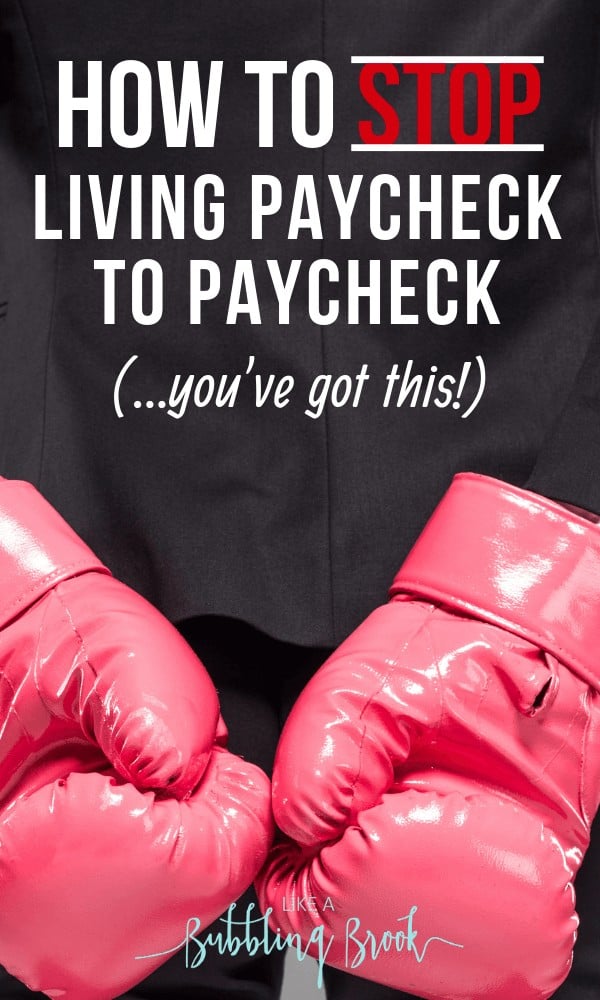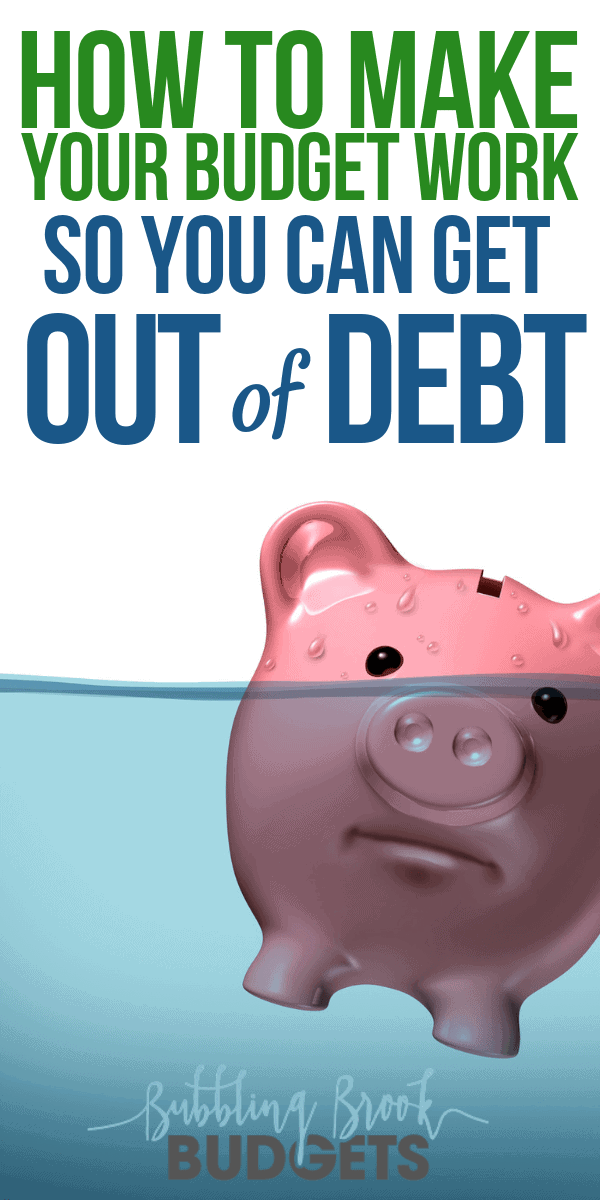
You’re probably here, reading about how stop living paycheck to paycheck, because you know it’s not really living – it’s more like barely surviving.
You’re tired of scraping by.
You need a change. You know it. But how do you get there?
Several years ago, before my husband became a pastor, he was laid off from his job. At the time, I had just begun homeschooling our oldest son, and we were in the process of adopting our second son.
To say I was scared when he was laid off was an understatement! We’d just lost our only source of income! I had to learn how to completely put my trust in God and His provision for our family.
This was also the season where He led me to learn about how to be more frugal than I ever thought possible. Thankfully, we’d been budgeting for years, so I was able to go through our budget and prayerfully slash absolutely everything that wasn’t a necessity. I knew what we were spending and what we really needed.
You might also like:
- We’re Debt Free! How We Paid Off Everything, Even Our House
- A Prayer For Finances: How To Pray When Money’s Tight
- My Dave Ramsey Meal Plan For A Beans + Rice Budget
I can’t imagine going through that hard time if we’d been living paycheck to paycheck. Thankfully, we’d gotten on a budget and had made a financial plan before that hard season came — and I want to help you do it, too.
Someone shared a statistic with me this week: 78% of Americans are living paycheck to paycheck. That’s a scary number! When you’re living paycheck to paycheck, you’re always gambling with whether or not you will have enough money for your bills, groceries, or even gas for the car. One emergency could put you into debt, or leave you and your family stranded. It doesn’t have to be that way!
There are so many benefits to stop living paycheck to paycheck, and if you’re ready to make a change, here’s how to get started.
Table of Contents
How To Stop Living Paycheck To Paycheck

Learn how to budget
If you want to get out of the living paycheck to paycheck cycle, you first need to learn how to budget. A budget is going to teach you how to live on less than what you make and create a deficit in your spending to put toward savings and other financial goals down the road. Creating a budget and putting it into practice are two different things. The budget you create in this step needs to be a guideline for how you live your life and the purchases that you make.
You can create your budget on paper (which I recommend for your first budget; here’s my Printable Budget Toolkit) and later move to an app like Mvelopes (you can read my review and get a free trial here).
You might also find this post helpful: The Printable Budget Planner That Helped Us Finally Get Debt Free
Live on less
In order to break the cycle, you need to be spending less money than you have coming in. Freeing up this money will help you cushion your emergency fund, build savings, and eventually pay off debt as well. This extra sum of money can help you out in a tough situation or be there when you need it in an emergency. Living on less can also help prepare you for tough times when you may need to live on a lower income.
Here are some posts I’ve written that will help you live on less:
- 50 Cheap Meals For Families That Even The Kids Will Love
- How To Earn Amazon Gift Cards (Or, How I Paid For Christmas One Year)
- 19 Ways To Save Money On Groceries Without Coupons
Find areas of your life to downsize/simplify
This is going to help you not only create that deficit in your budget, but allow you some wiggle room for your financial goals. Downsizing doesn’t necessarily mean selling your house, but changing your lifestyle.
Do you need to pay for cable and Netflix?
Are three cars really necessary?
Do you have to have three cell phones and a landline?
These answers can help you cut back on some of the costs that are causing you to live paycheck to paycheck.
One area many families need to downsize is in their food costs. This is especially true when you’re tired and dragging the kids along to the grocery store, only to make tons of impulse purchases and spend way more than you’d planned.
If that’s you, trying a service like emeals makes a huge difference and can save you time and money. I first heard about them through Dave Ramsey. They create your meal plan for the week (you tell them what kind of meals you like, and if you want a budget meal plan, etc), send your shopping list to your local WalMart (or other store), and you can just pull up — they’ll bring your groceries out to you.
If you’d like to try them out for a couple weeks, you can sign up for their free trial offer here.
Find ways to increase your income
Maybe it’s as simple as getting a raise at work, but if not, there’s still hope. We live in a day and age where making money “on the side” is easier than ever! Lots of families have a side hustle. Whether it’s delivering pizza a couple nights a week, to starting your own money-making blog (like I did! read about it here), to finding small “stay-at-home-mom jobs” you can do in your little pockets of free time. You’ve got this!
Here are some posts I’ve written that might help you increase your income:
- 9 Stay At Home Jobs That Are Perfect For Your Noisy Home
- How To Make Money Proofreading From Home
- Why You Might Want To Try Becoming an Online Tutor
- Making Money From Home By Teaching English to Children in China
Get rid of the credit cards
You don’t want to jeopardize the hard work you’ve done to get you to this stage in the game. If you already have an emergency fund built up, it’s time to cut the credit cards. These will give you a false sense of security and may encourage you to spend more than you normally would. Instead, cut them up and rely on your emergency fund to help you when you are in an emergency.
If you don’t have an emergency fund, then do whatever it takes to get at least $1000 into one. Have a garage sale, sell things on FB or Craigslist, donate plasma, whatever it takes. Don’t use your credit cards as a crutch that may eventually lead you into debt. Cut them up!
Start living a month ahead
Your savings goal should be to thrive on last month’s income. This is going to be a gamechanger and help you budget. Instead of living for each paycheck, focus on saving one month’s earnings in addition to your emergency fund. If you are ever in a tough spot, you have a month of paychecks lined up without any issue.
Then, when you’ve hit that goal, make your next goal to increase your savings up to 3-6 months of your pay.
If you’d like a super-detailed plan for getting out of debt, I highly recommend Dave Ramsey’s book Total Money Makeover.
Anyone can break the cycle and stop living paycheck to paycheck. While it may not be easy, you’ll be so glad you did!
Let’s chat soon,


New to my site? I love to share ways to get out of debt, save more money, and make extra money from home. You can take a look at my recommendations page for products and web sites I use to do that!
Be sure to check these out, too:
Mvelopes: This is the online budgeting program we personally use and LOVE. In fact, we purchased a lifetime membership several years ago when they offered it to us. It’s like a virtual cash envelope system, and it syncs with your bank accounts. Here’s my full Mvelopes review, or you can click here for a free 30 day trial of Mvelopes.
![]() Personal Capital: Personal Capital is much more detailed than Mvelopes, and is more centered on helping you with your investing rather than your budgeting. You can track your net worth, cash flow, investments, retirement planning, and more. Personal Capital pretty much picks up where Mvelopes has left off. They even offer a free version of their services. Check them out here.
Personal Capital: Personal Capital is much more detailed than Mvelopes, and is more centered on helping you with your investing rather than your budgeting. You can track your net worth, cash flow, investments, retirement planning, and more. Personal Capital pretty much picks up where Mvelopes has left off. They even offer a free version of their services. Check them out here.
Blogging: This is how I make good money from home while being a stay-at-home mom, and I love it. If you’d like to learn more, read my post about How to Start a Blog. It’s actually quite easy to get started! Keep researching afterwards and learning how to do new things, one thing at a time. You’ll keep getting better, and your income will increase each month.



Leave a Reply